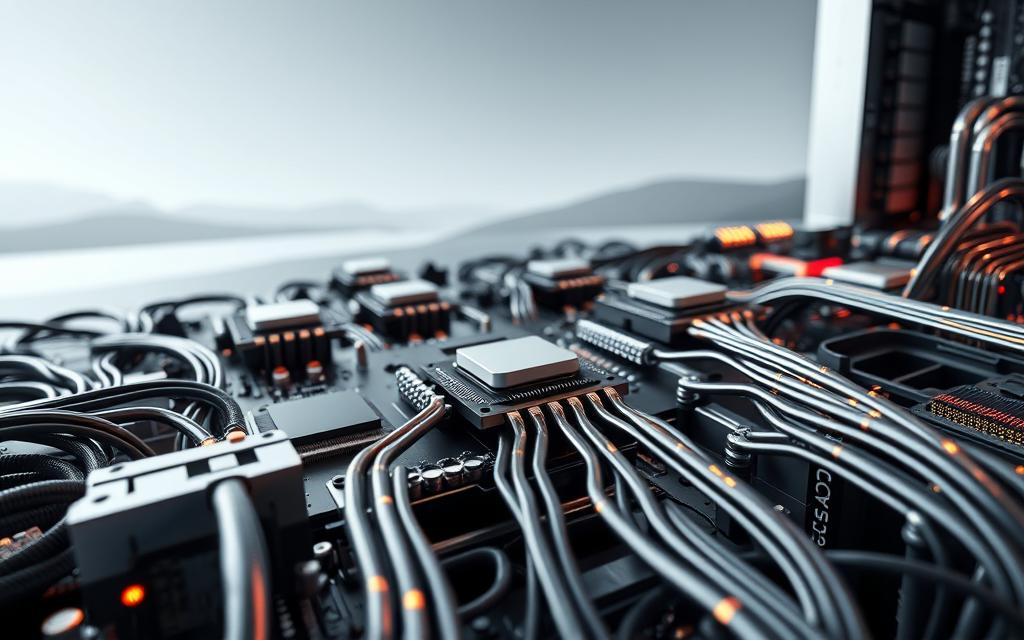The bus system serves as the fundamental communication pathway in computer architecture, enabling data transfer between various hardware components. These specialised electrical pathways carry data, addresses, control signals, and power throughout the computer system.
Understanding bus systems is crucial for comprehending how computers process and transfer information between components like the CPU, memory, and peripheral devices. The efficiency of bus systems directly impacts overall computer performance, determining how quickly data can move between critical components.
Understanding Bus Systems in Computer Architecture
The bus system serves as the backbone of computer architecture, allowing for the exchange of data between various system components. To grasp its significance, it’s essential to delve into the definition and historical development of bus systems.
Definition and Basic Concept
A bus system in computer architecture refers to a communication pathway that enables the transfer of data between different components of a computer system. It is a shared transmission medium that allows multiple components to exchange data, enhancing system performance and speed. The bus width, which determines the amount of data that can be transmitted simultaneously, is a critical factor in system performance.
Historical Development of Bus Systems
The evolution of bus systems has been closely tied to the development of computer architecture. Initially, bus implementations were narrow in width and slow in speed, limiting overall system performance. However, with advancements in technology, standardised bus architectures emerged in the 1970s and 1980s, such as the S-100 bus and ISA, marking significant improvements in computer design. As computing requirements became more complex, bus systems evolved to include multiple specialised buses, increasing data throughput and reducing latency.
- The development of bus systems parallels the advancements in computer architecture, from simple single-purpose buses to sophisticated architectures.
- Early bus systems were limited by their narrow width and slow speed, impacting overall system performance.
- Standardised bus architectures, such as S-100 and ISA, represented significant milestones in the history of computer design.
The Fundamental Components of a Bus System
Understanding the fundamental components of a bus system is crucial for appreciating its role in computer architecture. The bus system is a complex structure that relies on its constituent parts to function effectively.
Physical Structure and Connections
The physical structure of a bus system includes the various pathways and connectors that enable data transfer between different components. These pathways are typically made up of parallel or serial connections that facilitate the exchange of information. The quality and design of these connections can significantly impact the overall performance of the bus system.
Bus Controllers and Interfaces
Bus controllers serve as the traffic managers of the bus system, coordinating data transfer operations between various components. Some key aspects of bus controllers and interfaces include:
- Bus controllers determine which devices can access the bus at any given time, preventing conflicts and ensuring orderly data exchange.
- Bus interfaces provide the necessary hardware and protocols for components to connect to and communicate through the bus system.
- Modern bus controllers implement sophisticated arbitration schemes to prioritise bus access based on the urgency and importance of different operations.
- The efficiency of bus controllers and interfaces significantly impacts overall system performance, particularly in multi-component environments where bus contention can occur.
Thecontrolexerted by bus controllers is crucial for maintaining the integrity of data transfer within the system.
What is Bus System in Computer Architecture: A Comprehensive Overview
In computer architecture, the bus system plays a pivotal role in ensuring seamless data communication among various components. It acts as a shared communication pathway that allows different parts of the computer system to exchange information.
The Role of Bus Systems in Data Communication
Bus systems are crucial for facilitating data transfer between different components of a computer. They provide dedicated pathways for data to travel, ensuring efficient communication. The capacity and speed of these digital highways directly impact how quickly information can move throughout the computer system.
- The bus system enables data to be transmitted between various components, such as the CPU, memory, and peripherals.
- It includes mechanisms to control data flow, prevent collisions, and ensure efficient transfer, much like traffic management on a highway.
As noted by experts, “The bus system is the backbone of a computer’s architecture, allowing for the efficient transfer of data between different components.” This highlights the importance of a well-designed bus system in ensuring overall system performance.
Bus Systems as the Computer’s Highway
The analogy of a highway is often used to describe the function of a bus system in computer architecture. Just as highways have lanes for different types of vehicles, computer buses often have separate lines for different types of signals (data, address, control). The highway analogy extends to concepts like traffic management, congestion, and prioritisation, all of which have parallels in how bus systems manage data communication.
According to a renowned computer architect, “The design of the bus system is critical in determining the overall performance of the computer system.” This underscores the significance of bus systems in computer architecture.
In conclusion, the bus system is a vital component of computer architecture, facilitating efficient data transfer and communication among various components. Its design and functionality have a direct impact on the overall performance of the computer system.
Types of Buses in Computer Architecture
Understanding the different types of buses is essential for grasping how computer architecture functions. In computer systems, buses serve as the primary means of communication between various hardware components. These buses facilitate the exchange of data, addresses, and control signals, enabling the system to operate efficiently.
Data Bus: The Information Carrier
The data bus is responsible for carrying data between different components of the computer system. It is a bidirectional bus, meaning it can transfer data in both directions, allowing for reading and writing of data to and from the memory or I/O devices. The width of the data bus, measured in bits, determines the amount of data that can be transferred simultaneously, thus impacting the system’s overall performance.
Address Bus: The Location Finder
The address bus carries memory addresses from the CPU to the memory or other peripherals. It is a unidirectional bus, as it only needs to send addresses from the CPU to other components. The width of the address bus determines the maximum amount of memory that can be addressed by the CPU, thus influencing the system’s memory capacity.
Control Bus: The Traffic Controller
The control bus acts as the traffic controller of the computer system, carrying control signals that coordinate and synchronise activities between components. These signals include read/write commands, interrupt requests, clock signals, and various status indicators that manage system operations. The control bus enables the CPU to communicate specific instructions to memory and I/O devices, such as whether to perform read or write operations.
| Type of Bus | Function | Directionality |
|---|---|---|
| Data Bus | Carries data between components | Bidirectional |
| Address Bus | Carries memory addresses from CPU to memory or peripherals | Unidirectional |
| Control Bus | Carries control signals to coordinate activities between components | Varied, depending on the signal |
Bus Architecture Classifications
The way bus architectures are classified significantly impacts the performance and capabilities of computer systems. Bus architectures can be broadly categorised based on their functionality and scope within the system.
Internal vs External Buses
Internal buses operate within the computer, connecting critical components such as the CPU and memory. External buses, on the other hand, facilitate communication between the computer and external devices. The distinction between internal and external buses is crucial for understanding system design and expansion capabilities.
System, Expansion, and I/O Buses
System buses, often referred to as front-side buses, serve as the primary pathway for data transfer between the CPU and main memory. Expansion buses provide slots for adding optional components, such as graphics cards, using standards like PCI and PCIe. I/O buses handle input/output operations between the computer and peripheral devices, utilising protocols like USB and SATA.
Understanding these classifications is essential for appreciating how different buses contribute to the overall efficiency and expandability of a computer system.
Bus Timing and Synchronisation
In computer architecture, bus timing and synchronisation play a crucial role in ensuring efficient data transfer between components. The bus system relies on precise timing to coordinate data exchanges, making it essential to understand the mechanisms that govern bus operations.
Synchronous Bus Operations
Synchronous bus operations are governed by a central clock signal that synchronises data transfers between components. This clock signal ensures that all transactions occur at a predetermined time, simplifying the design of the bus system. The synchronous approach relies on a consistent cycle time, allowing for predictable data transfer rates.
Asynchronous Bus Operations
In contrast, asynchronous bus operations do not rely on a central clock signal. Instead, they utilise handshaking protocols to coordinate data transfers. These protocols involve the exchange of control signals that indicate when data is ready to be sent, received, or when the next transfer can begin. Asynchronous buses can accommodate components operating at different speeds, offering greater flexibility.
| Bus Operation Type | Clock Signal Dependency | Flexibility |
|---|---|---|
| Synchronous | Dependent | Limited |
| Asynchronous | Independent | High |
Technical Characteristics of Bus Systems
Understanding the technical characteristics of bus systems is essential for evaluating their efficiency and performance in computer architecture. These characteristics determine how effectively a bus system can transfer data between different components of a computer.
Bus Width: Impact on Data Transfer Capacity
The width of a bus, typically measured in bits, directly affects its data transfer capacity. A wider bus can transfer more data in parallel, thus enhancing the overall data transfer rate. For instance, a 64-bit bus can transfer 64 bits of data simultaneously, making it more efficient than a 32-bit bus. The bus width is a critical factor in determining the performance of a computer system, as it influences how much data can be processed at once.
Bus Speed and Bandwidth
Bus speed, typically measured in MHz, refers to the frequency at which the bus operates and determines how many transfer cycles can occur per second. Higher bus speeds enable faster data transfers but also face challenges such as signal integrity and electromagnetic interference. Bandwidth, the product of bus width and speed, represents the total data transfer capacity of the bus, usually expressed in bytes per second. Modern bus architectures employ techniques like double data rate (DDR) transfers to increase effective bandwidth. Key considerations include:
- Bus speed and its impact on data transfer rates
- The relationship between bus width, speed, and bandwidth
- Techniques to enhance bandwidth, such as DDR transfers
- The importance of balancing bus speed with other system components to prevent bottlenecks
By understanding these technical characteristics, one can better appreciate the complexities involved in designing and optimizing bus systems for improved computer performance.
Evolution of Bus Technologies
The evolution of bus technologies has been a crucial factor in the development of modern computer systems. Over the years, bus systems have transformed significantly, influencing the overall performance of computer architectures.
First Generation Bus Systems
First-generation bus systems were characterized by simple, shared bus architectures. These early systems were limited by their design, which often resulted in bottlenecks and reduced system performance.
Second Generation Bus Systems
Second-generation bus systems introduced improvements such as increased bandwidth and more sophisticated bus control mechanisms. However, they still relied on shared bus architectures, which limited their scalability.
Third Generation Bus Systems
Third-generation bus systems, which emerged around 2001, feature point-to-point connections rather than shared pathways. Modern implementations like PCI Express use serialized data transfer with dedicated lanes for each device, eliminating many limitations of shared bus architectures. As noted in a study on computer buses, “
the shift to point-to-point connections has dramatically improved system bandwidth and overall performance
- Point-to-point connections, resembling networks more than traditional buses
- Sophisticated protocols and routing capabilities
- Support for simultaneous transfers between multiple device pairs
- Dramatic increase in overall system bandwidth
| Generation | Characteristics | Performance Impact |
|---|---|---|
| First Generation | Shared bus architecture | Limited by bottlenecks and reduced system performance |
| Second Generation | Increased bandwidth, shared bus | Improved performance, but limited scalability |
| Third Generation | Point-to-point connections, serialized data transfer | Dramatic increase in system bandwidth and performance |
Common Bus Standards and Protocols
In computer architecture, bus standards and protocols are essential for facilitating communication between different components. These standards ensure that data is transferred efficiently and reliably between various parts of the system.
Parallel Bus Standards
Parallel bus standards transfer data in parallel, using multiple wires to send multiple bits simultaneously. Although they were once widely used, they have largely been replaced by serial standards due to limitations such as increased electromagnetic interference and higher pin counts.
Serial Bus Standards
Serial bus standards, on the other hand, transfer data one bit at a time over fewer wires, using higher frequencies to achieve competitive bandwidth. Modern examples include USB, SATA, and PCI Express, which have become ubiquitous in modern computing.
| Bus Standard | Description | Advantages |
|---|---|---|
| USB | Universal Serial Bus | Hot-swappable, high-speed data transfer |
| SATA | Serial ATA | High-speed data transfer, reduced cable clutter |
| PCI Express | Peripheral Component Interconnect Express | High-speed data transfer, scalable, flexible |
Serial buses offer several advantages, including reduced electromagnetic interference, lower pin counts, and better scalability to higher speeds. The transition from parallel to serial standards represents one of the most significant shifts in computer bus architecture in recent decades.
The Front Side Bus and Modern Architectures
As computer architectures evolved, the limitations of the traditional Front Side Bus became apparent, prompting the development of more efficient alternatives. The Front Side Bus, once a critical component, facilitated communication between the CPU and other system components.
FSB: The Critical Communication Path
The Front Side Bus served as the primary interface between the CPU, memory, and other peripherals, playing a crucial role in determining system performance. However, its shared bus architecture often led to bottlenecks, limiting overall system efficiency.
Modern Alternatives to Traditional Bus Systems
Modern computer architectures have largely replaced the traditional FSB with more efficient memory controller designs. For instance, Intel’s QuickPath Interconnect and AMD’s HyperTransport introduced point-to-point connections between the CPU and memory controller, eliminating shared bus bottlenecks. Current designs often integrate the memory controller directly into the CPU, providing shorter, faster paths to memory. These modern approaches offer significantly higher bandwidth, reduced latency, and better scalability for multi-core processors, thereby enhancing overall performance in contemporary computing applications.
As noted by a industry expert, “The evolution beyond traditional bus systems has been essential for supporting the performance requirements of modern computing applications.”
Bus Systems and Computer Performance
A well-designed bus system is essential for optimising computer performance and preventing bottlenecks. The bus system’s efficiency directly impacts the overall speed and data transfer capabilities within a computer.
Impact on System Speed
The bus system’s design and capabilities significantly influence the overall system speed. When the data transfer rate of the bus is not in line with the processing power of connected components, it can lead to reduced system performance.
Bottlenecks and Optimisation Strategies
Bus bottlenecks occur when the data transfer capabilities cannot keep up with the processing demands. Common optimisation strategies include:
- Implementing cache systems to reduce bus traffic
- Using wider buses for critical pathways
- Employing more efficient bus protocols
Modern system designs often utilise hierarchical bus architectures, allocating faster buses for critical components and slower buses for less demanding peripherals. Optimisation must balance performance with cost, power consumption, and compatibility.
| Optimisation Strategy | Benefits |
|---|---|
| Cache Systems | Reduces bus traffic, improving overall system performance |
| Wider Buses | Increases data transfer capacity for critical pathways |
| Efficient Bus Protocols | Enhances data transfer efficiency, reducing bottlenecks |
Conclusion
The bus system remains a crucial element in computer architecture, facilitating data transfer between various components. Throughout this article, we’ve explored the definition, types, and evolution of bus systems, highlighting their critical role in computer functionality.
Bus systems have evolved significantly, from simple shared pathways in early computers to sophisticated point-to-point connections in modern architectures. The technical characteristics of buses, including width, speed, and protocol efficiency, continue to be crucial factors in overall system performance. As computing technology advances, bus systems will likely continue to evolve, with trends toward higher speeds and more efficient protocols.
Understanding bus systems provides valuable insight into the fundamental workings of computer architecture and the challenges of efficient data movement. As we look to the future, developments in bus technology will focus on reducing latency, increasing bandwidth, and supporting the ever-growing demands of modern computing applications, all within the context of time-sensitive processing.













